Cucumbers are famous summer fruits and are easy to grow. Cucumbers can be prolific once they start growing. But nothing is more disappointing than watching a plant thrive but without fruits.
Cucumber plants may not produce due to lack of pollination, improper watering, poor soil conditions, pests, and diseases. Cucumbers require adequate sunlight, water, and nutrients for optimal growth and production. Addressing any issues and providing proper care to encourage fruit production is important.
If you have faced this problem, you are not alone. A lot of growers have faced it. This article provides a few explanations about the reasons behind the problem and the solutions. Let’s get right into it without further delay.
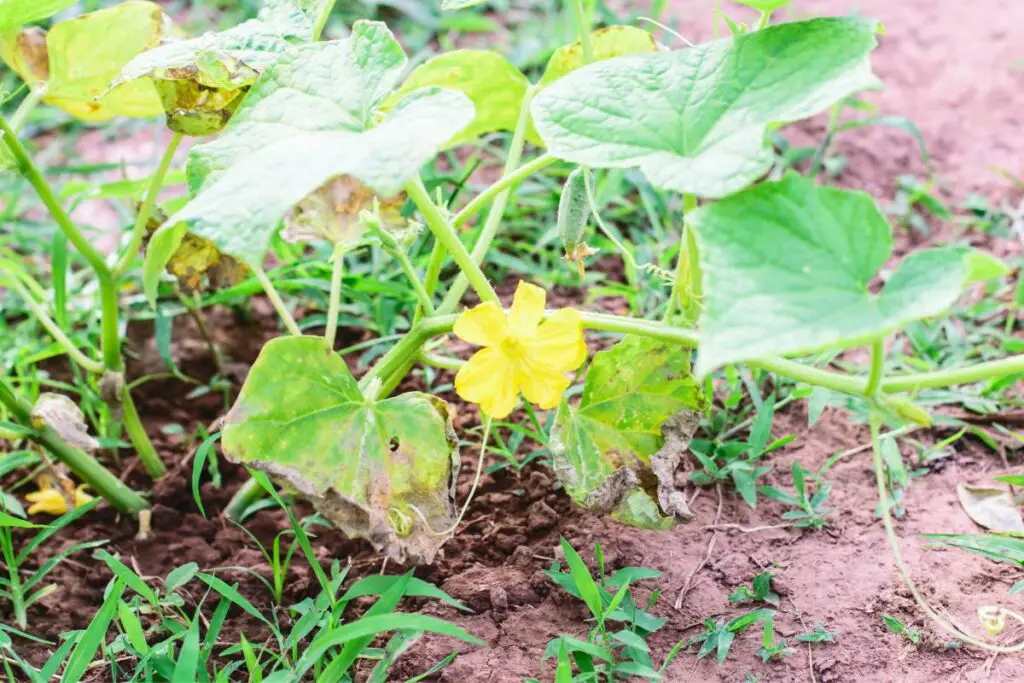
Lack of pollination
It is one of the most common problems behind cucumbers not producing fruits.
Besides proper care and maintenance, pollination is what leads to new fruits.
One reason behind the lack of pollination is your plant lacks male or female flowers.
Only male flowers
Most cucumber plants are monoecious, meaning they will have both male and female flowers on the same plant.
The male flowers have a shorter stem with clusters of 3 to 5.
These flowers produce pollen, which is further carried to the female flowers.
The female flowers bloom alone with long stems. Once the pollen reaches the female flowers, the female starts producing small fruits.
It makes the stem behind the female flower thick and swollen.
In a monoecious cucumber plant, the male and female flowers are produced in equal numbers.
But that does not happen at the same time.
The male flowers appear before the female flowers.
The plant uses its energy to grow the male flowers during the early growing season.
This ensures that the male flowers have enough pollen to pass to the female flowers and produce enough cucumbers.
The time gap between the growth of the male and female flowers depends on the cucumber variety.
If the time gap is too much, the female flowers will appear much later.
The season may be early for the female flowers to bloom.
So, when your plant doesn’t pollinate, your plant still has not developed any female flowers.
Sometimes, the female flowers take too much time to appear.
And the male flowers fall off after a day or two.
So, this can be a matter of concern for beginners.
But you do not need to worry; only the earliest flowers fall off.
The female flowers don’t bloom because you might have planted them late, and the hot temperatures affect the flowering process.
It is a warm temperature that encourages flower growth and not heated temperatures.
To increase female flower growth, plant the cucumbers when the soil temperature rises in spring or mid-spring.
Give your plants a bit of shade during the hottest time of the day to protect them from heat stress.
Another option is to grow the gynoecious varieties.
They grow only female flowers to receive more female flowers.
However, gynoecious varieties will lead to a lack of male flowers.
Let’s talk about them in the next section.
Gynoecious cucumbers
These cucumber varieties grow only female flowers and no male flowers.
Sometimes, they will have male flowers, but the numbers are so few that there are no chances of pollination.
The good thing is that they produce female flowers.
If you have monoecious varieties that have not grown female flowers yet, cross-pollination will the gynoecious varieties will lead to food production.
To increase the male flowers, plant some monoecious with gynoecious.
No self-pollination
If there is still a lack of pollination despite the presence of both male and female flowers, the flowers are not self-pollinating.
Self-pollination does not mean that the male’s pollen automatically travels to the female flowers.
It must be carried by natural means like wind or pollinators like bees, butterflies, and other insects.
Without proper pollination, your cucumber plants won’t have any fruits.
Your yard lacks bees because you have recently used pesticides and insecticides or the weather is rainy.
If that is the case, you can hand-pollinate. All you need is a small paintbrush or a cotton swab.
Find a male flower and brush the pollen with the brush or cotton swab.
Rub the brush or cotton swab into the inside of the female flower.
Be gentle, as the pollen is small and sticky.
For the best results, find the new male flowers.
These have higher chances of pollination than the old ones.
I also tried another method suggested by one of my friends.
I broke off the male flower and rubbed it against the female flower.
There is no need to feel guilty about this because, after the pollination, the male flowers will fall off.
So, there is no risk in it.
Fruit maturity after pollination
It depends on the type of varieties, for example:
- The slicing varieties will take 15 to 18 days to mature
- The small pickling varieties take 4 to 5 days, while large pickling varieties take 8 to 10 days to mature.
Looking for gardening supplies? We have tested 100's of products before recommending them to you guys. Check out our best pick below:
| Image | Gardening Supplies | Best Price? |
|---|---|---|
 Top
Top Top
Top | Raised Garden Bed Kit | Check On Amazon |
 | XLUX Soil Moisture Meter, Plant Water Monitor, Soil Hygrometer Sensor for Gardening, Farming, Indoor and Outdoor Plants, No Batteries Required | No Results |
 Top
Top Top
Top | 82 Pcs Garden Tools Set and Extra Succulent Tools Set | Check On Amazon |
 | Joeys Garden Expandable Garden Hose with 8 Function Hose Nozzle, Lightweight Anti-Kink Flexible Garden Hoses, Extra Strength Fabric with Double Latex Core, (50 FT, Black) | No Results |
 Top
Top Top
Top | Dual Chamber Compost Tumbler | Check On Amazon |
 Top
Top Top
Top | Sunnyglade Plant Stakes | Check On Amazon |
 Top
Top Top
Top | Organic Cold Pressed Neem Seed Oil | Check On Amazon |
 Top
Top Top
Top | Mighty Mint Gallon :-Insect and Pest Control Peppermint Oil | Check On Amazon |
 Top
Top Top
Top | Scotts DiseaseEx Lawn Fungicide | Check On Amazon |
 Top
Top Top
Top | Jacks Classic 20-20-20 All Purpose Fertilizer | Check On Amazon |
 Top
Top Top
Top | 30,000 Seeds Pollinator Attracting Wildflower Mixture | Check On Amazon |
 Top
Top Top
Top | Survival Vegetable Seeds Garden Kit-Over 16,000 Seeds | Check On Amazon |
Insufficient sunlight
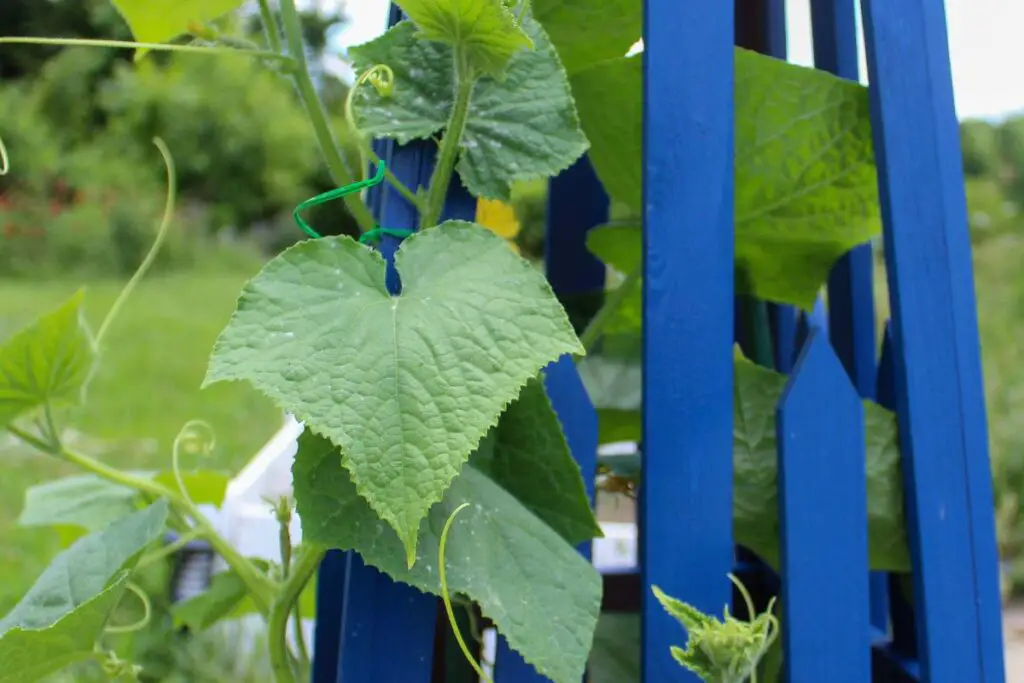
For cucumbers, an adequate amount of sunlight is significant.
Without enough sunlight, the plant may grow flowers, but there won’t be any fruits.
Cucumbers perform best when they receive 8 to 10 hours of sunlight daily.
If not that much, at least 6 to 8 hours of sunlight is a must for them.
When they do not get optimal sunlight, the plants will struggle with photosynthesis and chlorophyll production, have stunted growth, and there won’t be any flowers.
Even if there are flowers, they will fall off without producing any fruits.
To solve this problem, ensure the plant receives at least 6 to 8 hours of sunlight daily.
You can protect them with shade during the hottest time of the day but do not completely block the sunlight.
Inadequate watering
Cucumbers are 96% water.
Insufficient moisture levels negatively impact the plant’s overall growth and development.
Along with sunlight, it will also need enough moisture for adequate photosynthesis.
Also, remember that evenly moist soil is what the cucumbers need.
The soil must be evenly moist and not wet.
Otherwise, you end up with overwatering and root rot.
The rule is to maintain consistent watering.
If you water the plant, let it dry for too long, and then again overwater it after a long time, this will disturb the plant’s growth and development.
This fluctuation in the moisture consistency will stress the plant, leading to a reduction in flower growth and fruit development.
The consistency of the moisture level depends on various factors like the soil, temperature, and season.
The plant must receive moisture 2-3 times per week.
The best way is to check the moisture level and water the plant when the top few inches have dried.
Or, use a soaker hose or drip irrigation system to ensure that the cucumbers stay evenly watered while minimizing water waste.
The method will give water directly to the plant roots without wetting the leaves.
Checking the moisture level will let you understand whether your plant has overwatering or underwatering issues.
So, if you see discolored or wilted leaves, check the soil first.
Another way is to add an inch layer of mulch to keep the moisture from trapped and the plant hydrated during the hot weather.
Extreme temperatures
The cucumbers need 75 to 85°F temperatures to thrive and produce fruits.
Both extremely high and low temperatures will affect flowering and fruit production.
Low temperatures
The lowest temperature the cucumbers can tolerate is 50-55°F.
Temperatures below 50-55°F will weaken the plant and kill it.
The plant will slow down growth and reduce flowering and fruit development.
The flowers bloom at a warm temperature.
If the weather is so cold, there won’t be any flowers, and therefore no pollination.
The female flowers are known to bloom in cool weather.
So, I had a confusion here.
Then one of my friends explained that temperatures below 50-55°F are freezing for them to bloom. So, there won’t be any flowers.
Low temperatures during the rainy season also reduce the activity of pollinators, leading to no fruits.
To protect the plant from cold weather, take it inside if it is in a pot.
Use row covers or frost covers to protect them from cold weather.
High temperatures
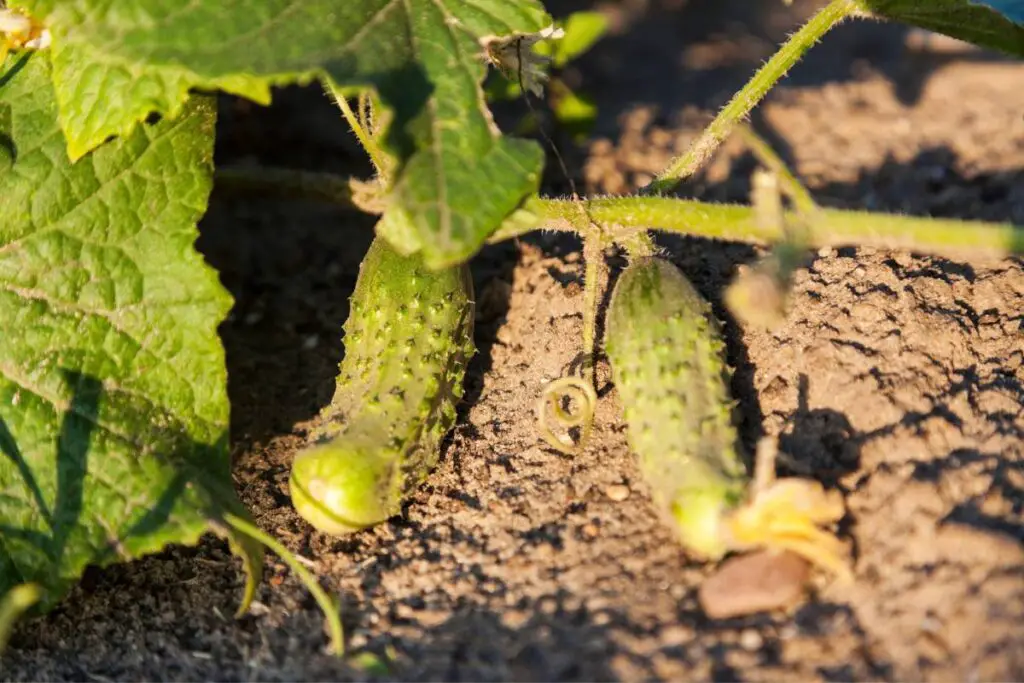
Above 95°F, the plant gets heat stressed, and the bloomed flowers fall off without producing fruits.
If the temperature is too high, the flowers get stressed by the excessive heat.
They will show their stress by dropping off without producing any fruit.
Protect your plant from excessive sunlight by providing shade, keeping the plant hydrated consistently, and adding a layer of mulch to keep the moisture from evaporating.
Improper fertilization
Over-fertilizing the cucumbers or fertilizing them with the wrong type reduces fruit growth.
Excessive fertilizers can overwhelm the plant and encourage it to grow only leaves and vines but no flowers and fruits.
Common symptoms are no fruits, yellow leaves, defoliation, and brown edges indicating fertilizer burns.
Lack of fertilizers will also have the same issue.
Without enough nutrients, the plant may grow but won’t look healthy.
So, there won’t be any fruits and flowers.
Some common signs of nutrient deficiency are yellow or wilted leaves and stunted growth.
The cucumbers are fertilized in 3-4 stages:
- Before planting, when you prepare the soil
- During mulching after planting
- When the cucumbers are growing or they start flowering
When the plant grows or starts flowering, apply liquid fertilizers every 2 weeks for 8 weeks.
If you use a slow-release fertilizer, apply it only once a month.
High nitrogen levels
Another problem is the fertilizer’s nutrient levels, i.e., the NPK.
Cucumbers will need less nitrogen and more potassium and phosphorus.
Excessive nitrogen levels in the soil will also overwhelm the plant.
Nitrogen will only encourage vegetation. But there won’t be any flowers or fruit.
Stop using fertilizer if your soil has a high nitrogen level.
Then, flush the soil to soak it thoroughly with a garden hose.
Do it earlier in the day before the sunlight’s intensity increases and dries up the excess water.
Use a fertilizer that is high in potassium and phosphorus and low in nitrogen.
For example, a fertilizer with 2-3-6, 3-4-6, or 3-6-6 NPK.
Or, use a balanced fertilizer with a 10-10-10 NPK value.
You can also go for organic fertilizers like compost manure, worm castings, neem or mustard cake, bone meal, and sea meal.
Poor soil conditions
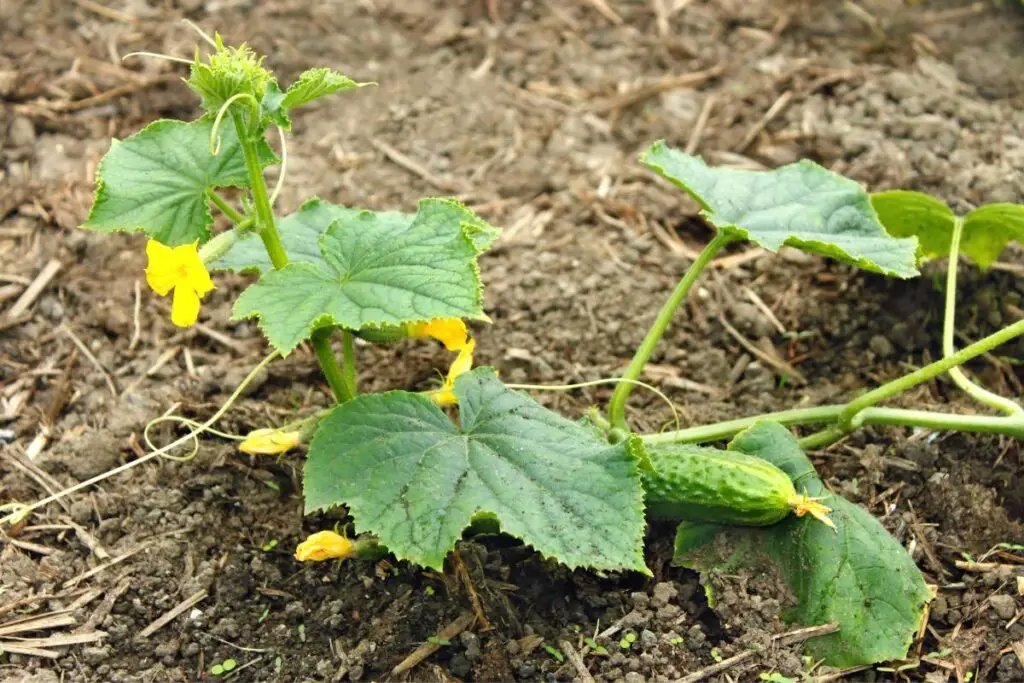
Soil conditions for the cucumbers are essential for adequate fruit production.
Cucumbers can grow in any soil. But that does not make them thrive.
The soil must be well-drained, nutrient-rich, and loamy for the best performance.
This soil type is essential for the plant’s overall growth and development.
If the soil condition is poor, like too compact, poorly-drained, too sandy soil, or poor in nutrients does not allow your plant to thrive.
Compact and poorly-drained soil leads to overwatering, whereas sandy soil leads to underwatering.
If the soil is not nutrient-rich, it leads to poor plant development.
With these problems, the plant will struggle to produce quality fruits.
Add organic matter if the soil is too heavy, too light, or infertile for the cucumbers. It will fix all the problems.
Another concern is the soil pH. The ideal soil pH is 6.0 and 6.5.
If the soil’s pH is too low or high, it will impact the nutrient level and create an imbalance.
As a result, there will be stunted growth and reduced or no yields.
Test your soil’s pH with a tester.
If the level is low, add sulfur or a de-acidifier. For high pH levels, add limestone.
Lack of pruning
Pruning the cucumber plant is beneficial for fruit production.
The vines are uncontrollable, especially the vining varieties.
That is why people grow them in trellis to give them enough space.
But excessive growth is not suitable for fruit production.
Too many leaves and vines use all the provided nutrients and other resources to grow more vines and leaves.
So, the plant cannot concentrate on making flowers and fruits.
Pruning will let the plant use the provided resources to make flowers and fruits and stop the overgrowth of leaves and stems.
Furthermore, pruning gives the plant better access to sunlight for photosynthesis and airflow to encourage fruit growth.
However, be careful not to prune too much as that will stress the plant, again leading to no fruits.
Aim for the lower leaves. Pruning leaves from the top part will expose the fruits to direct sunlight.
Plant age
The age of the plant will also affect the production of the fruits.
In the early stage, the plant focuses more on the plant’s vegetation, the vines, stems, and leaves.
So, you won’t find any fruits at this stage.
After that, it enters the flowering stage, where the flowers will turn into fruits.
Over time, when the plant ages, it will lose the energy and ability to grow any flowers or fruits.
Its reproductive capacity reduces and results in no fruits.
Also, older plants have less tolerant to stress and become more susceptible to pests and diseases.
During any stress or infestation, there is rarely any chance for the plant to have any fruits.
There is no solution for this. Keep collecting the seeds from the previous fruits and grow more plants.
Pests and diseases
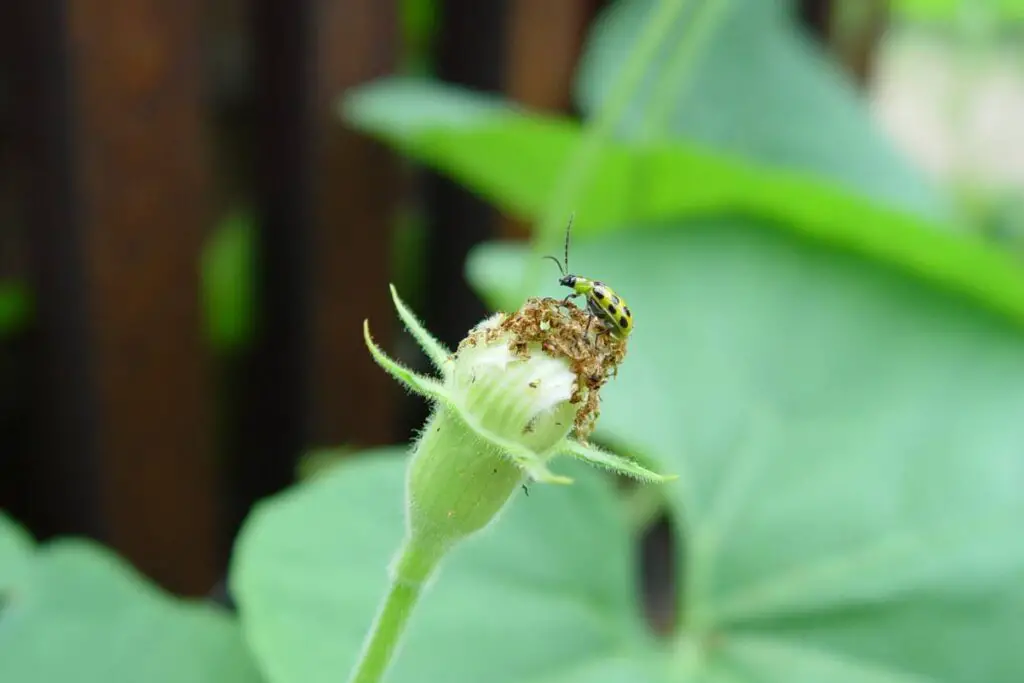
Pests and diseases are detrimental to all plants, and cucumbers are no exception.
Once the plant gets affected by pests or diseases, you can only receive yields if you fix the problem.
Bugs like aphids, spider mites, mealybugs, and whiteflies suck the plant sap and weaken the plant’s vigor and reduce fruit development ability.
Pests like cucumber beetles will directly attack the flowers.
Feeding on the flowers will lead to a reduced pollination rate and no fruit development.
Some pests are disease carriers and transfer the pathogens of viruses and fungi, resulting in diseases like powdery mildew, leaf spot, anthracnose, mosaic virus, and others.
Once diseased, the plant cannot produce any fruits or flowers.
When your plant gets attacked by pests or diseases, watch for the signs of infestation.
For example, the leaves will have holes and stickiness if aphids, spider mites, or whiteflies attack the plants.
When you check under the leaves, you can spot the pests.
If there is powdery mildew, the leaves will have powder-like spots.
In mosaic virus, the leaves have yellow mosaic-like patterns.
To deal with pests:
- Quarantine your plant from other plants. The pests can spread faster, especially if you grow other cucumber varieties or cucurbits like pumpkins, squashes, or melons.
- Wash your plant thoroughly with a garden hose to dislodge the pests.
- Spray neem oil or other insecticidal soaps on the affected areas. You can use Encarsia formosa to deal with whiteflies.
- Remove the affected leaves. Keep the surroundings neat and clean.
- Avoid stressing your plant.
- To deal with diseases:
- Quarantine your plant and examine it closely to confirm whether you can save it.
- Remove the wholly damaged leaves from it.
- Add some copper fungicide to the plant to avoid the disease from spreading.
- To prevent the disease, grow disease-resistant varieties.
- Remove the weeds around the cucumber plants and keep the surroundings neat and clean.
- Avoid growing neighbors close to each other, like pumpkins, melons, zucchini, and squashes.
Final thoughts
These are some possible reasons behind a cucumber not producing any fruits. If you are facing the same problem, go through this article. Find out which one your plant is facing and try to solve it as explained.
If you cannot do anything about it, consult an expert in gardening for help. Take care of your plant by giving it adequate sunlight, watering, and fertilizers.
Use the correct type of soil and protect them from severe temperatures. Prune your cucumbers when you notice too much leaf growth. For successful pollination, grow monoecious with gynoecious, try to pollinate manually with hand, and add some companions like sunflowers, nasturtiums, and marigolds to attract pollinators.
Keep an eye on the plants regularly to check for pests and diseases. If you find any signs of infestation, isolate and treat the plant as needed. Spraying some neem oil in the first place can prevent the infestation from spreading.
How long will the cucumber plants form fruits after flowering?
Usually, the plants will start making fruits a few days after successful pollination. But it will depend on the variety and your planting time. Keep an eye on your cucumbers to note this.
How do I confirm that my cucumber plant has pollinated successfully?
After the cucumber flowers are successfully pollinated, the male flowers will wither and fall off the plant automatically, and the female flowers will grow fruits. If both male and female flowers are falling off without any fruits, the flower has not pollinated.
Reference: Cucumber Wikipedia
